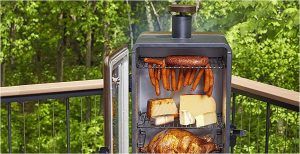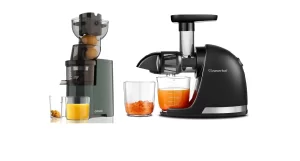Skillet vs. Frying Pan vs. Sauté Pan: Choose the Right One
Note: This article may contain affiliate links, which means if you make a purchase following our links won’t cost you extra, but we may earn a commission. Learn more
Skillet vs. Frying Pan vs. Sauté Pan: A Comparative Analysis dives into the unique characteristics and optimal uses of these essential kitchen tools. Each has its own strengths, suited to different cooking techniques, making your culinary experience more versatile and enjoyable.
The skillet, often made of cast iron, is the heavyweight in the kitchen, celebrated for its superb heat retention and even distribution. It’s your ally for achieving that perfect sear on a steak or baking a hearty cornbread. The key is its ability to go from stovetop to oven effortlessly, making it a versatile choice for a wide range of recipes.
On the other hand, the frying pan, typically lighter and made from materials like aluminum or stainless steel, is the go-to for everyday cooking tasks. Its slightly sloped sides make it ideal for quick frying, tossing, and turning foods. If you’re aiming to whip up a batch of pancakes, sauté vegetables, or fry an egg to perfection, the frying pan is your best bet. It heats up quickly, ensuring your food cooks evenly and rapidly.
The sauté pan stands out with its wide base and straight sides, offering a larger surface area for cooking. This design minimizes moisture loss, making it perfect for sautéing, simmering sauces, or even braising meats. If your dish involves liquids or you’re cooking in larger quantities, the sauté pan’s capacity and design ensure everything cooks uniformly, maintaining flavors and textures.
Each pan serves a distinct purpose in the kitchen, and choosing the right one can elevate your cooking game. Whether searing, frying, or sautéing, having the right tool for the task not only makes the cooking process smoother but also enhances the final dish.
So, consider what you love to cook most often and select your pans accordingly. With the right skillet, frying pan, or sauté pan in hand, you’re well-equipped to tackle any recipe with confidence.
Skillet Vs Frying Pan Vs Sauté Pan: Recommendation
Lodge 10.25 Inch Cast Iron Pre-Seasoned Skillet
Discover the classic American skillet with the Lodge 10.25 Inch Cast Iron Skillet, a testament to over 125 years of excellence in cookware craftsmanship. This skillet is more than just a pan; it’s a piece of history, made in the USA with the finest iron and oil for a naturally seasoned cooking surface that enhances with every use.
Its unmatched heat retention and even cooking transform meals into memorable moments, whether you’re searing steaks on the stove or baking cornbread over a campfire. The signature teardrop handle and helper handle make maneuvering easy, while the dual pour spouts add convenience.
Embrace the durability and versatility of this skillet, which is poised to help you create delicious, shareable meals for generations.
Key Benefits:
- Made in the USA
- Naturally seasoned for easy release
- Unparalleled heat retention
- Versatile use across cooking surfaces

Compatible For:
- Oven
- Stove
- Grill
- Campfire
Tramontina Professional Fry Pans (12-inch)
Step into professional cooking with the Tramontina Professional 12-inch Fry Pan, engineered to withstand the demands of a busy kitchen while providing the versatility needed for daily use. This fry pan features commercial-grade, heavy-gauge aluminum construction for quick, even heat distribution.
The reinforced nonstick surface ensures effortless food release and easy cleanup, making cooking a breeze. Its ergonomic cast stainless steel handle, equipped with a removable silicone grip, offers stability and comfort during use.
Whether you’re a seasoned chef or a cooking enthusiast, this NSF-certified fry pan is designed to perform, adapting seamlessly from the stove to the oven, and supporting a wide range of culinary endeavors.
Key Benefits:
- Quick and even heat distribution
- Reinforced nonstick surface
- Removable silicone handle grip
- NSF certified for quality

Compatible For:
- Gas, electric, and ceramic glass cooktops
- Oven-safe up to 400°F
Cuisinart Stainless Steel 5.5 Quart Sauté Pan w/ Cover
Elevate your cooking with the Cuisinart 5.5 Quart Sauté Pan, a beautifully designed piece that marries functionality with style. This pan’s high, straight sides and flat cooking surface maximize capacity, making it ideal for searing meats, sautéing vegetables, or simmering delicious sauces.
The aluminum encapsulated base heats quickly and spreads heat evenly, eliminating hot spots and ensuring professional results. Its mirror finish not only looks elegant but also offers durability and ease of cleaning.
The pan comes with a flavor lock lid and a cool grip handle, enhancing both safety and usability in the kitchen. It’s a versatile tool that brings Cuisinart’s renowned quality to your home, promising satisfaction with every use.
Key Benefits:
- Even and quick heat distribution
- High-capacity design with lid
- Cool grip handle
- Easy to clean and dishwasher safe

Compatible For:
- Induction cooktops
- Oven-safe
- Dishwasher-safe
Skillet, Frying Pan, Sauté Pan: Dissecting The Trio
The skillet is known for its heavy and thick walls. It’s often made of cast iron. This feature helps it retain and distribute heat evenly.
Skillets can go from stovetop to oven. They are perfect for searing meat and baking cornbread.
Frying pans have sloped sides and a flat bottom. They are lighter than skillets. This makes them easy to handle during fast cooking like sautéing. Frying pans come in various sizes, ideal for cooking a range of foods.
The sauté pan stands out with its straight sides and larger surface area. It often comes with a lid. This design is for cooking with liquid and for braising dishes. Its ample space is also good for cooking larger quantities.
Material Matters: Composition And Heat Conductivity
Cast iron skillets are famous for even heating and heat retention. These pans require seasoning to maintain their non-stick properties. Stainless steel skillets, known for durability, are great for browning and searing. They excel in heat distribution forgiving most types of cooking.
Non-stick frying pans offer easy cleanup and require less oil. They are ideal for delicate foods like eggs. Aluminum frying pans are lightweight and heat up quickly. Yet, they are not as good with heat distribution as other materials.
Copper sauté pans provide superior thermal conductivity. Food heats up fast and evenly. Clad sauté pans, with layers of different metals, ensure consistent heating with no hot spots. They are perfect for sautéing and frying a variety of dishes.
Culinary Battleground: Comparing Performance
The skillet excels at searing and browning meats. Its heavy build retains heat, ensuring even cooking. Perfect for achieving that crispy exterior on proteins.
Frying pans are masters of quick cooking tasks. Ideal for frying delicate eggs and tender pancakes. Their slightly sloped sides prevent food from sticking.
Sauté pans stand out with their straight sides and lid. They make tossing vegetables and simmering sauces a breeze. Their design allows for easy movements and flipping.
Choosing Your Champion: Best For Your Cooking Style
Skillets excel in cooking hearty, rustic meals. Ideal for those loving a home-style touch. Great for searing and browning meats. With high sides, they retain flavors well. Perfect for one-dish recipes.
The frying pan is a kitchen staple. Everyday cooking is easy with this versatile tool. It has sloped sides for easy tossing. Think omelets, pancakes, and sautéed vegetables.
For those serious about cooking, sauté pans are a must. They have straight edges and a larger surface. Such design is for even heat distribution. You can keep liquid from spilling over. They are aspiring chef’s allies for complex dishes.
How Do Skillet, Frying Pan, and Saute Pan Differ in Cooking Techniques?
The skillet, frying pan, and sauté pan are like the diverse tools in an artist’s toolkit, each designed with specific features that cater to different cooking techniques. Let’s dive into the nuances that set them apart. The skillet, often cast iron, is the heavyweight champion of heat retention and distribution.
It’s your go-to for recipes that require a sear or a bake, making it perfect for those hearty, oven-to-table dishes. The frying pan, with its lighter construction and sometimes non-stick surface, heats up quickly and is ideal for those meals that need quick cooking, such as omelets or sautéed vegetables.
The sauté pan, with its wider base and straight sides, shines when you need to stir or flip ingredients without making a mess, making it the preferred pan for dishes with sauces or liquids. Understanding these distinctions will guide you in selecting the right pan for the job, ensuring your dishes come out as intended.
What Are the Best Practices for Maintaining These Pans to Ensure Longevity?
Maintaining your cookware properly ensures it stays in top condition, serving up delicious meals for years. For skillets, particularly those made from cast iron, it’s essential to avoid soaking them in water or using soap. Instead, a quick scrub with a stiff brush and hot water followed by thorough drying will keep them rust-free. Re-seasoning with a thin layer of oil after cleaning preserves their non-stick qualities.
Frying pans, especially those with a non-stick coating, require gentle care. Use soft sponges for cleaning and avoid metal utensils during cooking to prevent scratching.
For sauté pans, regular washing with soapy water is usually fine, but always dry them immediately to prevent water spots and potential rust on any exposed metal parts. By following these practices, your cookware will remain in excellent condition, ready to tackle any recipe you throw at them.
Can You Mix and Match These Pans for Different Cooking Tasks, or Should They Be Used Specifically for Their Intended Purpose?
While each pan has its unique strengths, don’t be afraid to mix and match them for various cooking tasks. The skillet, with its robust heat retention, can be used for more than just searing; think baking a skillet cookie or even shallow frying.
The frying pan’s quick heat response makes it not only great for frying and sautéing but also suitable for a quick sear on thinner cuts of meat. The sauté pan, designed for liquids and sauces, can also be a vessel for cooking grains like rice or quinoa, where the straight sides help prevent boil-over.
This versatility underscores the importance of understanding your cookware’s capabilities and not being afraid to experiment.
Remember, the best cooking tool is the one that allows you to cook with confidence and creativity.
How Does the Choice Between These Pans Affect the Flavor and Texture of Food?
The pan you choose can have a significant impact on the flavor and texture of your food, emphasizing the importance of matching the pan to the cooking method. The skillet, thanks to its heat retention, excels at creating a deep, caramelized crust on meats, enhancing flavor through the Maillard reaction.
The frying pan’s ability to heat up and cool down quickly makes it perfect for delicate tasks like sautéing garlic without burning, preserving the subtle flavors. The sauté pan, with its larger surface area, allows for the reduction of sauces, concentrating flavors, and creating a silky texture that coats ingredients evenly.
Each pan offers a unique way to manipulate heat and surface contact, directly influencing the outcome of your culinary creations. By choosing the right pan for the task, you’re not just cooking; you’re crafting experiences that delight the senses.
Common Questions about Skillet, Frying Pan, and Sauté Pan
Can I Substitute a Frying Pan for a Skillet?
Yes, you can often substitute a frying pan for a skillet, especially for stovetop cooking tasks like sautéing or shallow frying. Both have similar designs, with the main difference being the material and slight variances in side slope. A frying pan, typically made from lighter materials, heats up faster, making it suitable for quick cooking tasks. However, for oven recipes or those requiring long cook times, a cast-iron skillet might be preferable due to its heat retention.
What Makes a Sauté Pan Different in Simmering Sauces?
A sauté pan is uniquely designed with straight sides and a lid, providing a larger surface area that’s ideal for simmering sauces. This design reduces spillage when stirring or tossing ingredients, and the lid helps to control evaporation, ensuring that sauces simmer gently and ingredients cook evenly. These features make the sauté pan superior for recipes requiring liquids, as it maintains consistent moisture levels better than a skillet or frying pan.
Why Is Cast Iron Preferred for Skillets?
Cast iron is preferred for skillets due to its exceptional heat retention and even heat distribution properties. It excels at cooking foods evenly, searing meats perfectly, and can transition from stovetop to oven without issue. Cast iron skillets improve with use, developing a non-stick surface over time through seasoning. This makes them a durable choice that can last generations, becoming a staple in the kitchen for a variety of cooking methods.
How Do I Choose Between Non-Stick and Stainless Steel Frying Pans?
Choosing between non-stick and stainless steel frying pans depends on your cooking needs. Non-stick pans are ideal for cooking delicate foods that easily stick, like eggs or pancakes, requiring less oil for a healthier meal. Stainless steel pans are more versatile, suitable for searing, deglazing, and oven-use, offering durability and the ability to withstand higher temperatures. If you frequently cook dishes that require flipping or gentle cooking, go for non-stick. For searing and versatility, stainless steel is best.
Can Sauté Pans Be Used for Deep Frying?
While sauté pans can be used for deep frying due to their large surface area and deep sides, they are not the optimal choice compared to a dedicated deep fryer or a deeper skillet. The straight sides of a sauté pan do allow for easier access with utensils and can contain oil well, but temperature control might be more challenging compared to a deeper vessel designed for frying. For occasional frying in small quantities, a sauté pan can suffice, but use caution with oil levels and temperature.
Bottom Line
The journey through the world of skillets, frying pans, and sauté pans reveals a landscape rich with potential for culinary creativity. Each pan, with its distinct design and material, brings something unique to the table, affecting how heat is transferred, flavors are developed, and textures are achieved. By understanding the strengths and maintenance needs of each, you empower yourself to make informed choices in the kitchen, ensuring each dish you prepare is not only cooked to perfection but also bursting with the intended flavor and texture. Remember, the right pan doesn’t just make cooking easier; it makes your food taste better. So, embrace the diversity of your cookware, and let your culinary adventures begin.
Read More: The Best Single Burner Hot Plates





